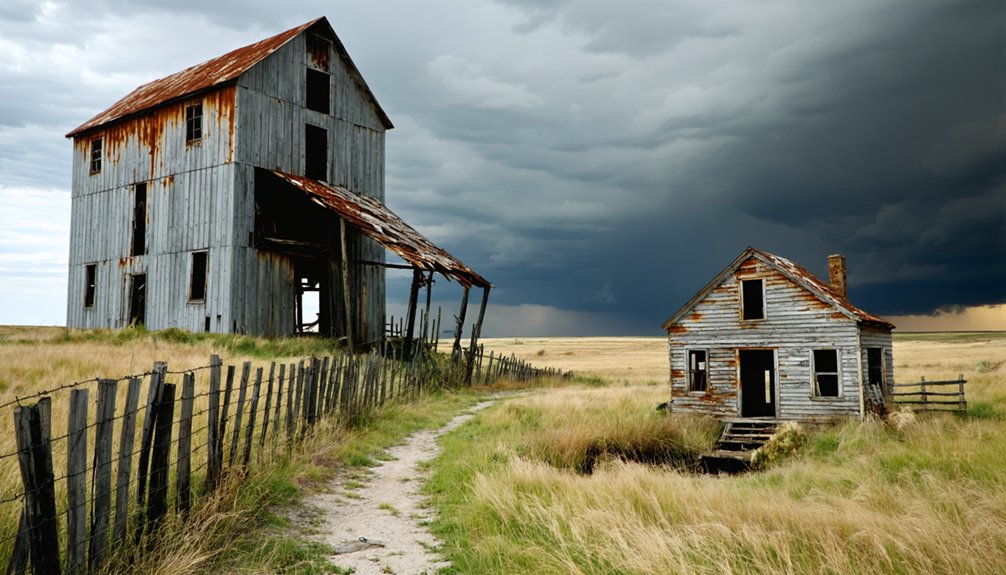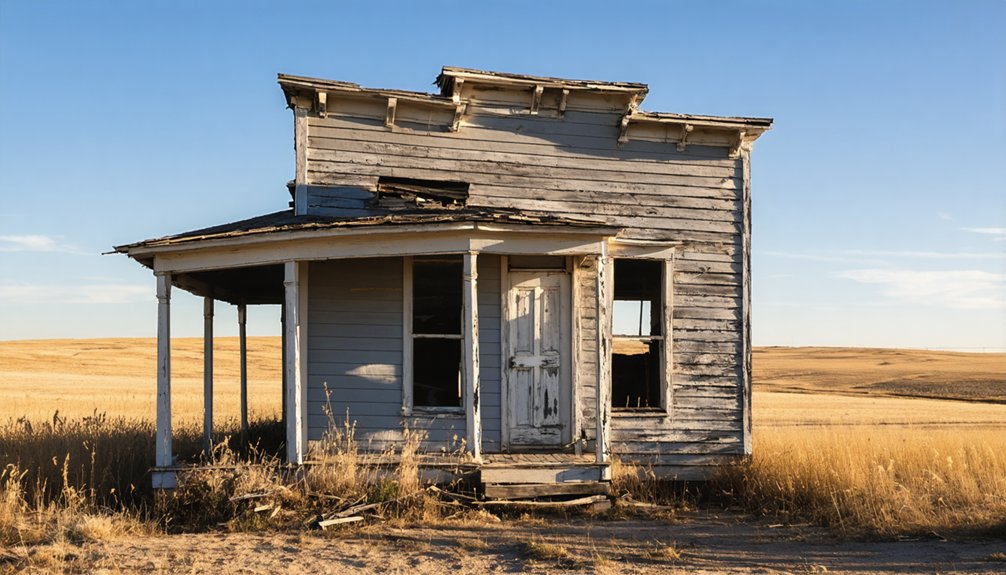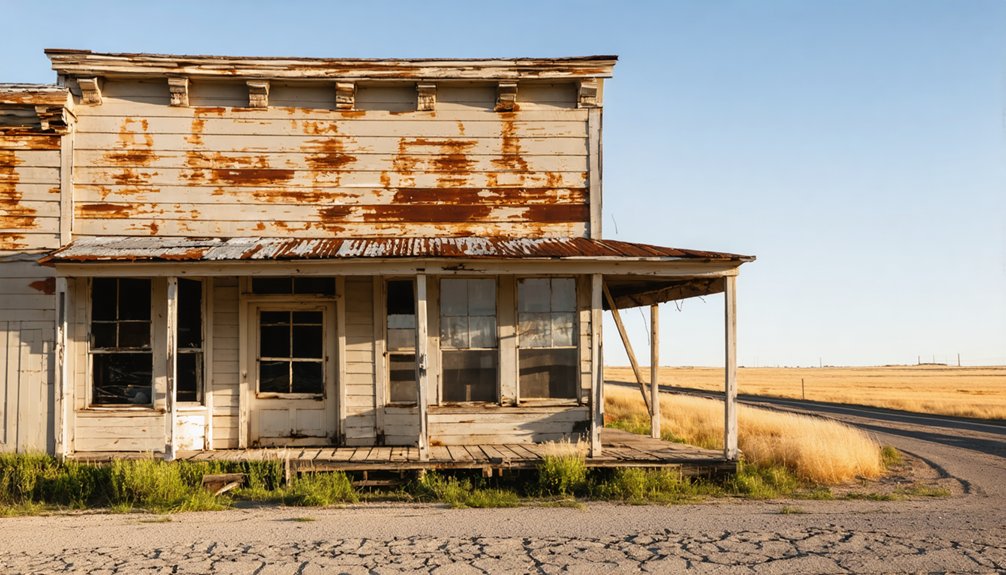When you explore Carbonate, South Dakota, you’ll discover the remnants of an 1880s silver mining boomtown that produced over $1 million in precious metals before its rapid decline. The remote ghost town sits frozen in time at coordinates 44°24′00″N 103°52′07″W in Lawrence County’s Black Hills, where collapsed mine shafts, ore bins, and stone foundations tell tales of frontier life. The site’s isolation has preserved its authentic character, though the stories of its hardy pioneers, deadly accidents, and community triumphs await beneath the surface.
Key Takeaways
- Carbonate was a silver boomtown established in 1881 after James Ridpath discovered silver-lead carbonate ore in South Dakota’s Black Hills.
- The town produced $1 million in silver, gold, and lead between 1881-1891, with Iron Hill Mine being the most productive operation.
- Located at 44°24′00″N 103°52′07″W in Lawrence County, Carbonate is now accessible only through challenging off-road terrain.
- Visitors can explore remnants including collapsed mine shafts, ore bins, and stone foundations of the former Black Hills Hotel.
- The ghost town has remained largely untouched since the 1880s, preserving authentic elements of Black Hills mining history.
The Birth of a Mining Frontier Town
Three key factors catalyzed Carbonate’s birth as a mining frontier town in July 1881: James Ridpath’s discovery of silver-lead carbonate ore, the establishment of the West Virginia Mine, and the rapid influx of prospectors drawn by news coverage in the Black Hills Daily Times.
You’ll find that pioneering mining techniques quickly transformed this raw frontier into a bustling settlement. Within months, over 200 men had staked their claims, bringing with them a fierce community spirit that would define the town’s character.
The establishment of The Carbonate Reporter newspaper in 1881 signaled the camp’s evolution from a mere mining outpost to a proper settlement. A newly constructed wagon road connected the growing town to Spearfish, facilitating trade and transportation. As the Black Hills mining boom gained momentum, the town’s identity shifted from West Virginia to Virginia, before finally settling on Carbonate – a name that proudly proclaimed its mineral heritage. By 1886, the town reached its zenith with a thriving population of 2,000 to 3,000 residents.
Life in the Black Hills Boomtown
As Carbonate evolved from a raw mining camp into an established settlement, its daily life mirrored the vibrant yet volatile nature of Black Hills boomtowns.
You’d have found yourself among a diverse mix of fortune-seekers living in hastily built wooden structures and tents, where mining culture emphasized both rugged individualism and tight-knit community bonds. By 1877, five newspapers operated during the peak of mining activity, keeping residents informed of local developments.
Life wasn’t easy – you’d have faced primitive sanitation, limited medical care, and the constant risks of mining accidents. The Homestake claim discovery in 1876 drew even more prospectors to Black Hills settlements like Carbonate.
While frontier justice tried to maintain order, saloons and gambling halls offered escape from the grueling work days.
You’d have witnessed a fascinating social tapestry where merchants, miners, and entertainers created an impromptu society.
Despite harsh conditions and uncertain profits, the town fostered a spirit of resilience as residents built makeshift schools, organized community events, and strove to carve out a civilized existence.
Silver, Lead, and Gold: The Mining Legacy
You’ll find Carbonate’s mining legacy defined by its impressive $1 million production of silver, gold, and lead from 1881 to 1891, with the Iron Hill Mine standing as its most productive operation.
Environmental concerns emerged in 1992 when acidic waters leaked from a massive 3.5-million-ton waste pile into nearby waterways. The acidification process was similar to how carbonate minerals decompose when exposed to high temperatures and acidic conditions.
The mining district’s economic importance hinged on silver prices, as evidenced by the mass closure of mines after the 1891 silver price collapse, though Iron Hill continued sporadic operations into the 1930s.
Ore processing required sophisticated smelting facilities built in 1885 to handle the complex mixture of precious metals embedded in the region’s distinctive carbonate and jasperoid formations.
Mining’s Economic Impact
Mining operations in Carbonate profoundly shaped the economic landscape of South Dakota’s Black Hills region during the late 19th and early 20th centuries.
You’ll find that silver drove initial growth, with peak production in the 1880s-1890s before prices crashed in 1891. The Iron Hill Mine showed mining sustainability through diversification, producing 18,511 ounces of silver and 91 metric tons of lead by 1901. The mine’s extensive network included 6,000 feet of workings across five distinct levels.
While silver’s decline triggered widespread mine closures, lead and gold helped sustain operations into the 1930s. The region’s mining legacy contributed greatly to economic diversification through infrastructure development, including railroads and urban facilities. According to Paul T. Allsman’s research, detailed mining district reconnaissance helped document the area’s mineral wealth.
However, you can trace Carbonate’s eventual downfall to the combined effects of falling metal prices, mine flooding in 1911, and dwindling opportunities, leading to its abandonment by 1939.
Ore Processing and Transportation
The discovery of carbonate ore in 1880 sparked a complex system of extraction and processing operations that would define Carbonate’s industrial character.
You’ll find the Iron Hill Mine‘s smelter at the heart of this system, processing silver, lead, and gold from two distinct ore types: fissure veins with gold-bearing iron gouge and solution cavity-filling deposits rich in lead and silver.
Despite the mine’s impressive output, transportation challenges shaped the town’s development.
Without direct rail access, miners relied on wagon trails and primitive roads to move ore and equipment. You can imagine the difficulties they faced hauling heavy loads through the valley terrain.
The smelter’s strategic placement near the mine helped minimize transport distances, though its operations left an environmental legacy – toxic fumes that reportedly killed local cats and affected workers’ health.
Daily Struggles and Triumphs
You’d find daily life in Carbonate consumed by the constant battle against harsh Dakota winters and the unforgiving demands of mining labor.
Your survival depended on basic amenities brought in by wagon roads, while the ever-present dangers of underground work claimed lives through accidents and injuries. Mary Morton’s boarding house operations provided essential lodging for the town’s mining workers. The discovery of precious metals had initially drawn waves of hopeful prospectors to the area.
If you managed the physical challenges, you still faced the mental toll of isolation, disease outbreaks, and the boom-and-bust cycle that ultimately led to the town’s abandonment.
Surviving Winter’s Harsh Reality
During the brutal winters of Western South Dakota, Carbonate’s residents faced a daily battle against nature’s harshest elements, with temperatures plunging to -25 degrees Fahrenheit and relentless blizzards threatening survival.
Your winter preparedness could mean the difference between life and death. You’d need to stockpile supplies, maintain sturdy shelter, and rely on thick, warm clothing to endure the punishing cold.
When blizzards struck, like the devastating Children’s Blizzard of 1888, you’d find yourself completely isolated, with snow covering the landscape for months. Yet community resilience prevailed – you’d share resources, support neighbors, and work together to overcome nature’s challenges.
The improved communication systems would warn you of approaching storms, though you’d still face the constant struggle of securing food, water, and essential supplies throughout the harsh winter months.
Mining Life Takes Toll
Mining permeated every aspect of life in Carbonate, where daily existence balanced precariously between potential wealth and constant danger. You’d face deadly mining hazards daily – from cave-ins and accidents underground to the toxic fumes from the town’s smelter that killed local cats and led to a devastating rat infestation.
The rats brought disease, triggering a catastrophic diphtheria epidemic in 1888-1889 that ravaged the population.
Yet community resilience shone through these dark times. Despite the constant threats, you’d find comfort in the town’s social fabric – gathering at the Black Hills Hotel’s saloon, reading the latest news in The Carbonate Reporter, or attending the local church.
Still, warning signs reading “Keep out: Black Diphtheria!” remained until 1910, a grim reminder of the price paid for mining prosperity.
Notable Characters and Pioneer Stories

While many pioneer tales from Carbonate have faded into history, several notable characters left lasting impressions on this Black Hills mining settlement.
James Ridpath and his son L.B. sparked the town’s birth in 1880 through their silver and lead discoveries. Pioneer women like Mary Morton shaped community life by running essential boarding houses that sheltered the town’s workforce.
Frank B. Bryant’s description of Carbonate as a “rip roaring camp” captures the raw frontier spirit that defined daily existence.
Not all stories ended triumphantly. John Tripp’s penniless death in 1888 and burial without possessions reflects the harsh realities many miners faced.
Today, weathered grave markers and crumbling foundations silently preserve the miner tales of both the renowned and forgotten souls who shaped this once-bustling settlement.
The Town’s Peak and Decline
During Carbonate’s heyday around 1886, you’d have found yourself among 2,000 to 3,000 residents in what was then a thriving Black Hills mining community.
The town’s prosperity rested on carbonate ore mining, with the extraction of silver and lead supporting diverse businesses including the territory’s largest hotel, the Black Hills Hotel.
You can trace the town’s rapid decline through its population loss – by 1900 only 380 residents remained, and the final blow came with the post office’s closure in 1909, effectively ending Carbonate’s status as an active settlement.
Population at Its Height
At its zenith in the 1880s, Carbonate’s population swelled to between 2,000 and 3,000 residents, transforming the settlement into a bustling hub of economic activity.
The town’s cultural heritage flourished as its economic diversity expanded, boasting multiple saloons, shops, and a prominent hotel. You’ll find that by August 1881, the construction of a wagon road connecting Carbonate to Spearfish enhanced the town’s accessibility and commerce.
The establishment of essential services marked Carbonate’s development into a proper town. A post office, church, bank, and mill served the growing population, while the opening of the first school in 1886 demonstrated the community’s commitment to education.
These amenities reflected the town’s evolution from a simple mining camp into a structured settlement with lasting aspirations.
Mining Industry Expansion
Mining operations transformed Carbonate into a powerhouse of mineral extraction by 1885, with the Iron Hill Mine leading the town’s industrial expansion. You’d have found several major mines dotting the landscape, including the Adelphi, Seabury-Calkins, and Cleopatra, each contributing to the town’s meteoric rise.
The evolution of mining technology brought significant changes, as evidenced by the construction of multiple cyanide plants to process ore tailings more efficiently.
However, this industrial progress came at a steep environmental impact. The town’s smelter, while essential for processing ore, released toxic fumes that devastated the local ecosystem and public health.
Despite attempts to modernize operations through improved milling techniques and infrastructure development, the combination of falling silver prices and deteriorating transport routes ultimately sealed the mining industry’s fate.
Post-Office Closure Impact
As the town’s prosperity peaked in the late 1880s, Carbonate’s post office served as a significant hub connecting the bustling mining community to the outside world.
You’d find it at the heart of daily operations, facilitating essential communications for mine operations, supply orders, and personal correspondence.
The post office’s eventual closure marked a turning point in Carbonate’s decline, leading to:
- Severe community isolation as mail routes shifted to distant towns
- Increased costs and delays for remaining businesses trying to maintain operations
- Loss of the town’s last formal connection to federal services
When the post office shuttered in the early 1900s, you could feel the ripple effects throughout the community.
Without this critical lifeline, the remaining residents faced mounting challenges that accelerated the town’s transformation into a ghost town.
What Remains: A Journey Through Time
Today’s visitors to Carbonate confront a landscape marked by decades of abandonment, where nature steadily reclaims what humans once built.
You’ll find the cemetery’s weathered wooden markers, with at least 11 graves telling silent stories of hardship, including John Tripp’s 1888 burial “with no property or valuables.” These graves stand as stark reminders of mining dangers, disease outbreaks, and violence that plagued the community.
Throughout the site, you’ll discover scattered building foundations, mining debris, and open shafts that hint at the town’s industrial past.
The West Virginia Mine’s remaining structures – ore bins and shaft houses – paint a picture of the silver-lead mining operations that once drove this frontier economy.
While private property restrictions limit access, the visible remnants offer glimpses into the raw realities of Black Hills mining life.
Hidden Dangers and Modern Challenges

Four major hazards confront anyone exploring the Carbonate site: deteriorating infrastructure, toxic chemical residues, unstable ground conditions, and legal restrictions.
Beyond these hidden hazards, you’ll face environmental concerns that make exploration particularly risky. Open mine shafts, crumbling structures, and chemical contamination create a dangerous landscape that’s further complicated by private property restrictions.
- Deteriorated mining structures and unmarked shafts pose immediate physical dangers
- Toxic residues from mining operations contaminate soil and water sources
- Private property status limits access and leaves you vulnerable to legal consequences
The site’s abandonment has led to accelerated decay, with eroding mine tailings and compromised groundwater quality presenting long-term risks.
Without proper oversight or preservation efforts, these hazards continue to multiply, making unauthorized exploration increasingly perilous.
Tales From the Cemetery
Beyond the physical hazards that mark Carbonate’s remains, the town’s cemetery tells a poignant story of frontier life and death.
You’ll find at least 11 known graves, their wooden markers weathered by time, each representing souls who carved out lives in this unforgiving terrain. The cemetery symbolism speaks volumes – scattered plots near the former townsite reflect the community’s struggle against disease, mining accidents, and harsh conditions.
John Tripp’s intricately carved headboard from 1888 stands as proof of the care frontier families took in honoring their dead, despite limited resources.
While most grave markers have succumbed to the elements, this sacred ground continues to reveal tales of diphtheria epidemics, mining disasters, and the high toll of infant mortality that shaped Carbonate’s brief but intense history.
Exploring the Ghost Town Today

Visitors exploring Carbonate’s rugged landscape will find a remote ghost town frozen in the late 1880s, accessible only through challenging off-road terrain at coordinates 44°24′00″N 103°52′07″W in Lawrence County’s Black Hills.
While traversing this mining heritage site, you’ll discover remnants of the once-bustling silver boomtown, including collapsed mine shafts, ore bins, and stone foundations from the territorial era.
For a meaningful ghost town exploration experience:
- Pack essential supplies and inform others of your plans – there’s no cell service or facilities
- Document but don’t disturb the historic features, including the Seabury Caulkins Mine ruins
- Study period maps before visiting to locate key sites like the Black Hills Hotel foundations
Your journey through Carbonate offers raw glimpses into Black Hills mining life, preserved by isolation and abandonment since the 1880s.
Frequently Asked Questions
What Was the Average Monthly Wage for Miners in Carbonate?
You’d find mining wages varied widely, but workers likely earned $50-125 monthly during Carbonate’s economic history, though payment often came as company scrip rather than cash, limiting actual take-home earnings.
Were There Any Native American Settlements Near Carbonate Before Mining Began?
Imagine walking ancient Lakota trails – you’ll find that Native settlements existed broadly in the Black Hills region, though specific cultural heritage sites at Carbonate aren’t documented before mining disrupted traditional indigenous land use.
Did Carbonate Have a School System for the Miners’ Children?
You’ll find Carbonate’s school history began in August 1886, serving miners’ children during the town’s peak. The miner education system operated briefly until the town’s decline following the 1888 diphtheria epidemic.
What Happened to the Mining Equipment When the Town Was Abandoned?
You’ll find most mining equipment was simply left behind after town abandonment, with machinery remaining at sites like Iron Hill Mine and the smelter due to costly removal and rapid evacuation.
Were There Any Documented Paranormal Activities in Carbonate’s Abandoned Structures?
While millions have wondered about ghost sightings, you won’t find any documented paranormal activities or haunted history in Carbonate’s ruins. Safety hazards and private property restrictions prevent formal investigations.
References
- https://blackhillsvisitor.com/learn/carbonate/
- https://briannaudreywright.wordpress.com/2015/10/02/carbonate-south-dakota/
- https://www.sdpb.org/rural-life-and-history/2023-08-21/some-black-hills-ghost-towns-and-their-origins
- https://scottprentice.com/carbonate-south-dakota-history/
- https://westernmininghistory.com/towns/south-dakota/carbonate/
- https://www.youtube.com/watch?v=zCQOa7W9iXg
- https://hikearizona.com/decoder.php?ZTN=21614
- https://thehillsiwander.files.wordpress.com/2016/12/historic-preservation-of-the-northern-black-hills1.pdf
- https://history.sd.gov/museum/docs/Mining.pdf
- https://csmsgeologypost.blogspot.com/2021_10_24_archive.html



